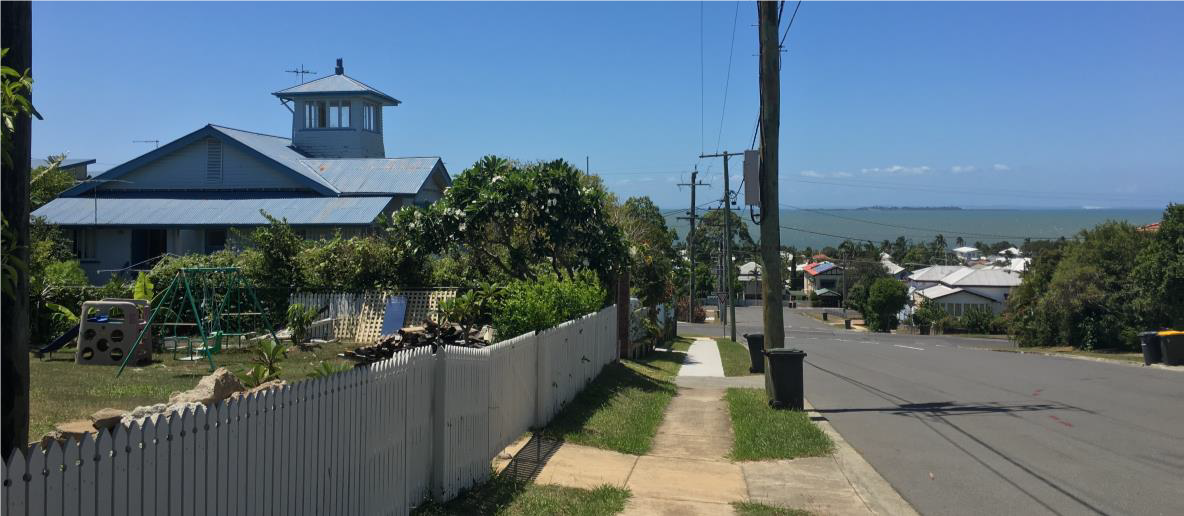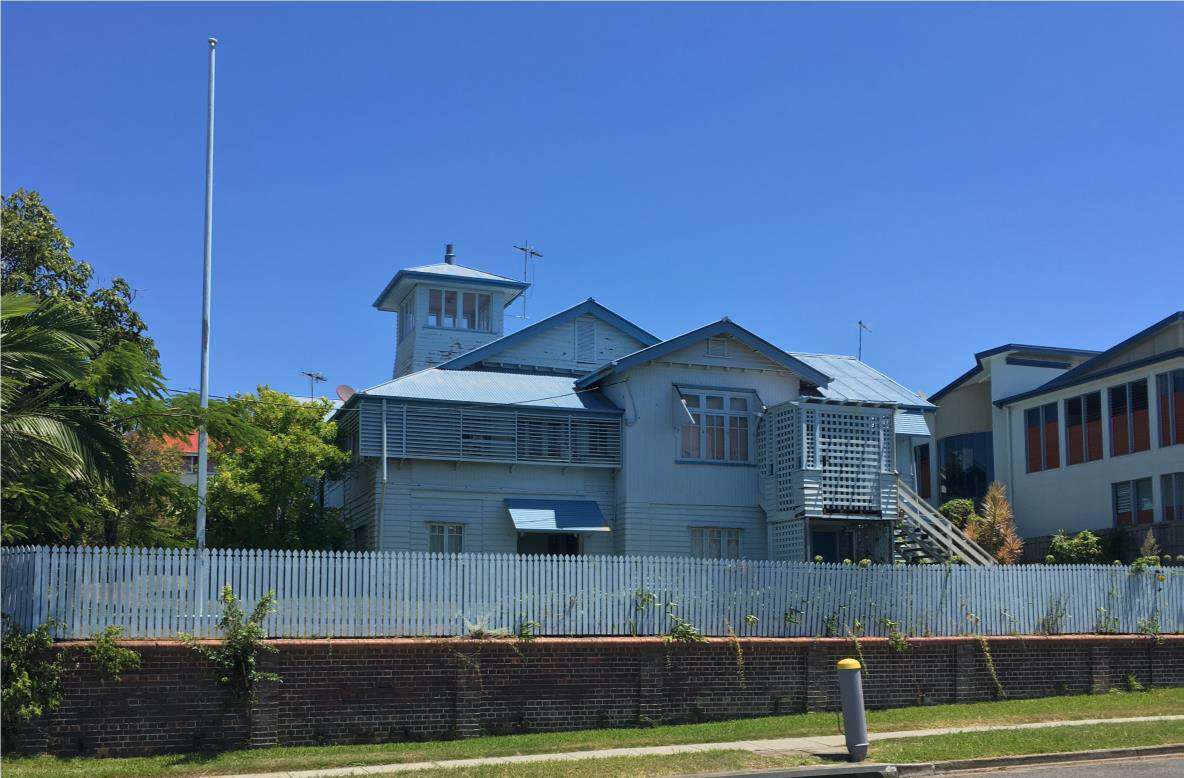Addresses
Type of place
Residential
Period
Interwar 1919-1939
Style
Queenslander
Addresses
Type of place
Residential
Period
Interwar 1919-1939
Style
Queenslander
Tower House was constructed circa 1921 for businessman and philanthropist John Darnell. Darnell lived in the property until his death in 1930. In 1945 the house was converted into flats for residential proprietor Margaret Burge, although it continued to be known as Tower or Towers House. It is an intact illustration of interwar architecture in Wynnum built during a period of strong residential growth in the area and is a local landmark with a distinctive silhouette.
Lot plan
L303_RP33008; L304_RP33008; L305_RP33008
Key dates
Local Heritage Place Since —
Date of Citation —
Criterion for listing
(A) Historical; (E) Aesthetic; (H) Historical associationInteractive mapping
Lot plan
L303_RP33008; L304_RP33008; L305_RP33008
Key dates
Local Heritage Place Since —
Date of Citation —
Criterion for listing
(A) Historical; (E) Aesthetic; (H) Historical associationInteractive mapping
History
Wynnum was first settled by Europeans from the 1860s. Land sales of this seaside area were slow until 1889 when the railway line was extended out from Brisbane through Wynnum to Cleveland. This encouraged development of the area as an alternative seaside resort to Sandgate and was particularly attractive to Brisbane’s southside residents. The initial large land holdings of the area were subdivided into smaller sites for closer development over time, including the large ‘Rose Bay Estate’, which was subdivided into many allotments of primarily 16 perches (405m2). These were offered for sale from the 1880s. As a result, purchasers bought either single allotments or a number of adjacent allotments to combine to make one larger property and the area developed as a residential neighbourhood with a small number of elite houses on relatively large land holdings, interspersed with many smaller, modest houses. As part of a large purchase of adjoining allotments in this sale, the three 16 perch allotments (totalling 1215m2) on the corner of Kingsley Terrace and Wolsey Parade sold in February 1889, and again in April, although no house was built on them at this time.
In 1920 retired businessman John Darnell purchased the three still-vacant allotments. Darnell had arrived in Queensland from England in 1878. The son of a successful London boot warehouseman, he began work as a commercial traveller for a boot company soon after his arrival. In the 1890s he switched to cigarettes, operating a tobacconists’ shop in Queen Street, Brisbane but returned to commercial travel in the early twentieth century. Darnell divided his time between Australia and England, where he had family and business interests. When in Brisbane, Darnell lived in the Wynnum-Manly area. His residence, ‘Darnville’, stood on nearby 6 Stratton Terrace and featured an observation tower, with commanding views of Moreton Bay. In 1916 Darnell advertised Darnville for sale on account of his return to England. The deaths of family members resulted in an inheritance which newspapers later reported as totalling £16,000, a huge sum of money at the time. Darnell spent much of the late 1910s and early 1920s travelling around the world. On returning to Australia, he again took up residence in Wynnum. His new property had significant advantages: the corner site was well elevated, providing even greater views of the bay and it fronted desirable Kingsley Terrace, which was a continuation of Wynnum’s principal street, Bay Terrace.
Darnell is likely to have engaged an architect to design his house at Kingsley Terrace. It stands in the centre of a generous yard and is a large, single-storey, high-set, timber-framed and -clad structure with multiple gables and a wrapping verandah. The house is crowned by a tall observation tower overlooking the bay and surrounding landscape. Darnell christened it ‘Tower House’.
During the early years of the twentieth century, Wynnum was experiencing a boom in development and population, growing in popularity as a holiday and retirement location for Brisbane residents. Entertainment facilities and shops were constructed along the foreshore, and in 1924 the town was described in glowing terms in the Brisbane Centenary Official Historical Souvenir:
The town and district of Wynnum stands among the foremost of Brisbane’s many beautiful watering places, not only because of its contiguity to the city and the facilities that exist for reaching it, but because of the natural charms with which the district is endowed and the salubrity and wholesomeness of its climate. In the possession of these attractions and attributes dwells Wynnum’s pre-eminent suitability as a holiday resort for all sorts and conditions of tired humanity seeking relaxation and recreation in the highest sense of the term.1
Darnell retired to ‘Tower House’ and became a philanthropist, donating money to the Wynnum and Manly Sailing Club and establishing a fund for struggling businessmen for the Commercial Travellers’ Association. He also took an interest in local matters, joining the Wynnum bowls club and scout group, and became vice-patron of the Wynnum Districts Music Society. He also expanded his property holdings. In addition to ‘Tower House’, Darnell had purchased the adjacent allotments behind the house, fronting Melville Terrace. Darnell engaged Brisbane architects AB and RM Wilson to design two houses on these allotments, which were built in 1926.
On his death in 1930 Darnell left significant sums of money to various Queensland institutions, including the University of Queensland, Church of England schools and the Queensland Ambulance Transport Brigade. The Darnell Art Gallery at UQ, opened in 1952, was named for him, as were the Church of England Grammar School’s Darnell Museum and St Margaret’s Church of England Girls School’s Darnell Art and Music buildings, both in Brisbane. Darnell had also granted £10,000 to the formation of a Queensland Art Gallery, on the provision that Queenslanders match the bequest. In 1935, as the time limit drew near, a flurry of fundraisers took place throughout Brisbane spearheaded by artists Daphne Mayo and Vida Lahey. The amount was successfully raised and the John Darnell Estate and Queensland National Art Gallery Act 1936 (Qld) was enacted to control the money, with the bequest funding acquisitions for the Queensland Art Gallery into the twenty-first century. Also funded by his bequests was an ambulance for the Wynnum Fire Brigade known as the ‘John Darnell Car’ and the ‘John Darnell Cup’, a Scouting award.
Darnell had no living relatives in Brisbane and his real estate passed to trustees. ‘Tower House’ was leased and in 1935 and 1936 the ‘beautiful home’ was advertised for lease or sale. At that time, as well as its eponymous tower, it was advertised as comprising three bedrooms, a maid’s room, dining room, kitchen and breakfast room, bathroom, garage and additional space under the house.
Despite its advantages, ‘Tower House’ was not sold until 1946 when it was transferred to Margaret Burge. Later that year she engaged a local builder to convert ‘Tower House’ into flats. Such a move was not unusual for large properties such as this one, which were unfashionable and increasingly difficult for owners to maintain after World War II. There was also growing demand for flat accommodation due to postwar housing shortages. It had been a trend since the 1920s for women to see economic potential in converting large houses into flats, managing the business, and gaining an income during a period of limited employment for women as they were ‘let go’ to provide jobs for returned soldiers. Burge herself had owned and operated multi-tenanted dwellings since the 1920s, most of which she had converted from large dwellings to self-contained tenements. The growing popularity of both flat-dwelling and Wynnum made the prospect of converting Darnell’s large house to flats viable for Burge. The property continued to be recognised as ‘Tower House’, even as flats.
The house was owned by the Burge family until 2002. In 2016, it continues to operate as a multi-unit dwelling and occupies its original land holding.
Description
Tower House stands on a large corner site facing Kingsley Terrace in Wynnum. It is a highly-intact, single-storey high-set timber-framed and -clad house with a multi-gabled roof clad with corrugated metal sheets. A tall, pyramid-roofed observation tower stands off-centre from the main roof and has casement windows on all sides. This distinctive element has impressive views of Moreton Bay and the surrounding landscape. It is also visible from the main shopping area of Wynnum, on axis with the end of Bay Terrace and is a local landmark. The house features characteristic formal massing, composition, detailing and material use of the interwar period realised though a high quality of design and craftsmanship. It has a picturesque arrangement of elements giving it a playful, nautical air. The house has weatherboard-clad walls with pylon-style paired verandah posts, ventilated eaves, and decorative lattice work. An early timber garage stands behind the house and an early, tall flagpole stands at the front corner of the garden, which features large areas of lawn. The yard is enclosed by a facebrick retaining wall with tall piers at the entrances and topped by a timber paling palisade.
Statement of significance
Relevant assessment criteria
This is a place of local heritage significance and meets one or more of the local heritage criteria under the Heritage planning scheme policy of the Brisbane City Plan 2014. It is significant because:
References
-
The Brisbane Centenary Official Historical Souvenir, Brisbane: Watson, Ferguson & Co, 1924, p195
-
Interpreting the modern: flatland in Brisbane 1920-1941, Helen Bennett, 2010, p 297
-
Brisbane City Council aerial photographs, 1946, 2012
-
Brisbane City Council Building Registers
-
Brisbane City Council, City Architecture & Heritage Team, heritage citations
-
Brisbane City Council Water Supply and Sewerage Detail Plans
-
Brisbane City Council, Properties on the Web, Building Cards
-
Department of Natural Resources and Mines, Queensland Certificates of Title
-
Margaret Maynard, ‘Lahey, Vida Frances (1882-1968)’, Australian Dictionary of Biography, National Centre of Biography, Australian National University, 1983
-
National Library of Australia, Trove digitised newspapers, Telegraph, Daily Mail, The Week, Brisbane Courier, Courier Mail, Daily Standard, Worker
-
Queensland Historic Births Deaths and Marriages
-
Queensland Legislation, An Act relating to Certain Trusts under the Will and Codicils of John Darnell, late of Wynnum South, in the State of Queensland, Gentleman, Deceased, 1936 (Qld)
-
Queensland Parliamentary Debates, 1959
-
Queensland Post Office Directories
-
Rushden Research Group: J Darnell and Son, website
-
UQ Fryer Library Manuscript Finding Aid, UQFL112 Wilson Architects Collection
-
University of Queensland, ‘Commemorative exhibition celebrates origins of University’s art collection’, April 2005
-
Wynnum Manly Historical Society Newsletter, No. 30, March 2011
Citation prepared by — Brisbane City Council (page revised September 2020)


